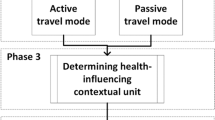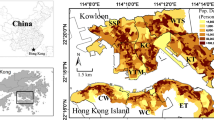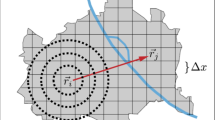Abstract
Background/aim
Active mobility may play a relevant role in the assessment of environmental exposures (e.g. traffic-related air pollution, livestock emissions), but data about actual mobility patterns are work intensive to collect, especially in large study populations, therefore estimation methods for active mobility may be relevant for exposure assessment in different types of studies. We previously collected mobility patterns in a group of 941 participants in a rural setting in the Netherlands, using week-long GPS tracking. We had information regarding personal characteristics, self-reported data regarding weekly mobility patterns and spatial characteristics. The goal of this study was to develop versatile estimates of active mobility, test their accuracy using GPS measurements and explore the implications for exposure assessment studies.
Methods
We estimated hours/week spent on active mobility based on personal characteristics (e.g. age, sex, pre-existing conditions), self-reported data (e.g. hours spent commuting per bike) or spatial predictors such as home and work address. Estimated hours/week spent on active mobility were compared with GPS measured hours/week, using linear regression and kappa statistics.
Results
Estimated and measured hours/week spent on active mobility had low correspondence, even the best predicting estimation method based on self-reported data, resulted in a R2 of 0.09 and Cohen’s kappa of 0.07. A visual check indicated that, although predicted routes to work appeared to match GPS measured tracks, only a small proportion of active mobility was captured in this way, thus resulting in a low validity of overall predicted active mobility.
Conclusions
We were unable to develop a method that could accurately estimate active mobility, the best performing method was based on detailed self-reported information but still resulted in low correspondence. For future studies aiming to evaluate the contribution of home-work traffic to exposure, applying spatial predictors may be appropriate. Measurements still represent the best possible tool to evaluate mobility patterns.
This is a preview of subscription content, access via your institution
Access options
Subscribe to this journal
Receive 6 print issues and online access
$259.00 per year
only $43.17 per issue
Buy this article
- Purchase on Springer Link
- Instant access to full article PDF
Prices may be subject to local taxes which are calculated during checkout



Similar content being viewed by others
References
Nieuwenhuijsen MJ, (ed). Exposure assessment in environmental epidemiology. 2nd ed. Oxford University Press; Oxford, 2015. ISBN 9780199378784.
Janssen NAH, Hoek G, Simic-lawson M, Fischer P, Van BreeL, Brink H, et al. Black carbon and health effects of airborne particles compared with PM10 and PM2.5 12. Environ Health Perspect. 2011;119:1691–9. https://doi.org/10.1289/ehp.1003369.
Beekhuizen J, Vermeulen R, Kromhout H, Bürgi A, Huss A. Geospatial modelling of electromagnetic fields from mobile phone base stations. Sci Total Environ. 2013;445–446:202–9. https://doi.org/10.1016/j.scitotenv.2012.12.020.
de Rooij MMT, Heederik DJJ, Borlée F, Hoek G, Wouters IM. Spatial and temporal variation in endotoxin and PM10 concentrations in ambient air in a livestock dense area. Environ Res. 2017;153:161–70. https://doi.org/10.1016/j.envres.2016.12.004.
Nyhan M, Grauwin S, Britter R, Misstear B, McNabola A, Laden F, et al. “Exposure track”—the impact of mobile-device-based mobility patterns on quantifying population exposure to air pollution. Environ Sci Technol. 2016;50:9671–81.
Smith JD, Mitsakou C, Kitwiroon N, Barratt BM, Walton HA, Taylor JG, et al. London hybrid exposure model: improving human exposure estimates to NO 2 and PM 2.5 in an urban setting. Environ Sci Technol. 2016;50:11760–8.
Breen MS, Long TC, Schultz BD, Crooks J, Breen M, Langstaff JE, et al. Assessments: model evaluation in central North Carolina. J Expo Sci Environ Epidemiol. 2014;24:412–20. https://doi.org/10.1038/jes.2014.13.
Gerharz LE, Pebesma E. Using geostatistical simulation to disaggregate air quality model results for individual exposure estimation on GPS tracks. Stoch Environ Res Risk Assess. 2013;27:223–34.
Mueller N, Rojas-Rueda D, Cole-Hunter T, de Nazelle A, Dons E, Gerike R, et al. Health impact assessment of active transportation: a systematic review. Prev Med. 2015;76:103–14. https://doi.org/10.1016/j.ypmed.2015.04.010.
Harrison F, Burgoine T, Corder K, van Sluijs EMF, Jones A. How well do modelled routes to school record the environments children are exposed to? a cross-sectional comparison of GIS-modelled and GPS-measured routes to school. Int J Health Geogr. 2014;13:1–12.
Vich, G, Urban Forestry & Urban Greening. (2018), https://doi.org/10.1016/j.ufug.2018.08.008.
Park YM, Kwan MP. Individual exposure estimates may be erroneous when spatiotemporal variability of air pollution and human mobility are ignored. Health Place. 2017;43:85–94. https://doi.org/10.1016/j.healthplace.2016.10.002.
Armstrong BG. Effect of measurement error on epidemiological studies of environmental and occupational exposures. Occup Environ Med. 1998;55:651–6.
Kelly P, Krenn P, Titze S, Stopher P, Foster C, Kelly P, et al. Quantifying the difference between self-reported and global positioning systems-measured journey durations: a systematic review transport reviews. Transport Reviews. 2013;33:443–59. https://doi.org/10.1080/01441647.2013.815288.
Klous G, Smit LAM, Borlée F, Coutinho RA, Kretzschmar MEE, Heederik DJJ, et al. Mobility assessment of a rural population in the Netherlands using GPS measurements. Int J Health Geogr. 2017;16:1–13.
Burgoine T, Jones AP, Namenek Brouwer RJ, Benjamin Neelon SE. Associations between BMI and home, school and route environmental exposures estimated using GPS and GIS: do we see evidence of selective daily mobility bias in children? Int J Health Geogr. 2015;14:1–12.
De Nazelle A, Seto E, Donaire-Gonzalez D, Mendez M, Matamala J, Nieuwenhuijsen MJ, et al. Improving estimates of air pollution exposure through ubiquitous sensing technologies. Environ Pollut. 2013;176:92–9. https://doi.org/10.1016/j.envpol.2012.12.032.
Dons E, Van Poppel M, Kochan B, Wets G, Int Panis L. Implementation and validation of a modeling framework to assess personal exposure to black carbon. Environ Int. 2014;62:64–71. https://doi.org/10.1016/j.envint.2013.10.003.
Fillekes MP, Röcke C, Katana M, Weibel R. Self-reported versus GPS-derived indicators of daily mobility in a sample of healthy older adults. Soc Sci Med. 2019;220:193–202. https://doi.org/10.1016/j.socscimed.2018.11.010.
Duncan MJ, Badland HM, Mummery WK. Applying GPS to enhance understanding of transport-related physical activity. Am J Prev Med. 2007;33:51–3.
Dalton AM, Jones AP, Panter J, Ogilvie D. Are GIS-modelled routes a useful proxy for the actual routes followed by commuters? J Transp Health. 2014;2:219–29. https://doi.org/10.1016/j.jth.2014.10.001.
Davies G, Whyatt D. A least-cost approach to personal exposure reduction. Trans GIS. 2009;13:229–46.
Pooley C, Whyatt D, Walker M, Davies G, Coulton P, Bamford W. Understanding the school journey: integrating data on travel and environment. Environ Plan A. 2010;42:948–65.
Kestens Y, Thierry B, Shareck M, Steinmetz-Wood M, Chaix B. Integrating activity spaces in health research: Comparing the VERITAS activity space questionnaire with 7-day GPS tracking and prompted recall. Spat Spatiotemporal Epidemiol. 2018;25:1–9. https://doi.org/10.1016/j.sste.2017.12.003.
Bringolf-Isler B, Grize L, Mäder U, Ruch N, Sennhauser FH, Braun-Fahrländer C. Personal and environmental factors associated with active commuting to school in Switzerland. Prev Med. 2008;46:67–73.
Jansen M, Ettema D, Pierik F, Dijst M. Sports facilities, shopping centers or homes: What locations are important for adults’ physical activity? A cross-sectional study. Int J Environ Res Public Health. 2016;13:1–19.
Ulfarsson GF, Shankar VN. Children’s travel to school: Discrete choice modeling of correlated motorized and nonmotorized transportation modes using covariance heterogeneity. Environ Plan B Plan Des. 2008;35:195–206.
Freidl GS, Spruijt IT, Borlée F, Smit LAM, Van Gageldonk-Lafeber AB, Heederik DJJ, et al. Livestock-associated risk factors for pneumonia in an area of intensive animal farming in the Netherlands. PLoS ONE. 2017;12:1–16.
Borlée F, Yzermans CJ, van Dijk CE, Heederik D, Smit LAM. Increased respiratory symptoms in COPD patients living in the vicinity of livestock farms. Eur Respir J. 2015;46:1605–14. https://doi.org/10.1183/13993003.00265-2015.
Klous G, Smit LAM, Freidl GS, Borlée F, van der Hoek W, IJzermans CJ, et al. Pneumonia risk of people living close to goat and poultry farms—taking GPS derived mobility patterns into account. Environ Int. 2018;115:150–60.
Landelijk Informatiesysteem van Arbeidsplaatsen, https://lisa.nl/home.
Esri/near_analysis. http://pro.arcgis.com/en/pro-app/tool-reference/analysis/near.htm.
The Netherlands’ Cadastre, Land Registry and Mapping Agency, https://www.kadaster.nl/.
Esri/network_analysis. http://pro.arcgis.com/en/pro-app/tool-reference/network-analyst/an-overview-of-the-network-analyst-toolbox.htm.
Esri/find-closest-facilities. http://pro.arcgis.com/en/pro-app/tool-reference/ready-to-use/find-closest-facilities.htm.
Schaap N, Harms L, Kansen M, Wust H. Cycling and walking: the grease in our mobility chain. Ministry of Infrastructure and the Environment, The Hague, 2016. http://english.kimnet.nl.
Huss A, Beekhuizen J, Kromhout H, Vermeulen R. Using GPS-derived speed patterns for recognition of transport modes in adults. Int J Health Geogr. 2014;13:40. https://doi.org/10.1186/1476-072X-13-40.
Statistics Netherlands (CBS), https://www.cbs.nl/nl-nl/achtergrond/2016/20/beroepsbevolking.
Scheiner J, Holz-Rau C. Travel mode choice: affected by objective or subjective determinants? Transportation. 2007;34:487–511. https://doi.org/10.1007/s11116-007-9112-1.
Axhausen K, Zimmermann A, Schönfelder S, Rindsfüser G. Observing the rhythms of daily life: a six-week travel diary Elektronische Daten. Transportation. 2002;29:95–124. http://en.scientificcommons.org/831369.
Flamm M, Kaufmann V. The concept of network of usual places as a tool for analyzing human activity spaces: an exploration based on the mobidrive large scale travel diary data set. In: Proceedings of the 11th World Conference on Transport Research. 2007. http://trid.trb.org/view.aspx?id=878244.
Vanwolleghem G, Schipperijn J, Gheysen F, Cardon G, De Bourdeaudhuij I, Van Dyck D. Children’s GPS-determined versus self-reported transport in leisure time and associations with parental perceptions of the neighborhood environment. Int J Health Geogr. 2016;15:1–12.
Vlakveld WP, Twisk D, Christoph M, Boele M, Sikkema R, Remy R, et al. Speed choice and mental workload of elderly cyclists on e-bikes in simple and complex traffic situations: a field experiment. Accid Anal Prev. 2015;74:97–106. https://doi.org/10.1016/j.aap.2014.10.018.
Zuurbier M, Hoek G, Hazel P Van Den, Brunekreef B. Minute ventilation of cyclists, car and bus passengers: an experimental study. Environ Health. 2009;8:1–10.
Chaix B, Méline J, Duncan S, Merrien C, Karusisi N, Perchoux C, et al. GPS tracking in neighborhood and health studies: a step forward for environmental exposure assessment, a step backward for causal inference? Health Place. 2013;21:46–51.
Su JG, Jerrett M, Meng YY, Pickett M, Ritz B. Integrating smart-phone based momentary location tracking with fixed site air quality monitoring for personal exposure assessment. Sci Total Environ. 2015;506–507:518–26. https://doi.org/10.1016/j.scitotenv.2014.11.022.
Acknowledgements
We like to thank all the participants, Lützen Portengen and Myrna de Rooij for statistical input and Daisy de Vries for textual input. The VGO GPS Study is funded by UMC Utrecht, publications fees for this article were available from IRAS. The Livestock Farming and Neighbouring Residents’ Health (VGO) study was funded by the Ministry of Health, Welfare and Sports and the Ministry of Economic Affairs of the Netherlands, and supported by a grant from the Lung Foundation Netherlands (Grant number: 3.2.11.022).
Author information
Authors and Affiliations
Corresponding author
Ethics declarations
Conflict of interest
The authors declare that they have no conflict of interest.
Additional information
Publisher’s note Springer Nature remains neutral with regard to jurisdictional claims in published maps and institutional affiliations.
Supplementary information
Rights and permissions
About this article
Cite this article
Klous, G., Kretzschmar, M.E.E., Coutinho, R.A. et al. Prediction of human active mobility in rural areas: development and validity tests of three different approaches. J Expo Sci Environ Epidemiol 30, 1023–1031 (2020). https://doi.org/10.1038/s41370-019-0194-6
Received:
Revised:
Accepted:
Published:
Issue Date:
DOI: https://doi.org/10.1038/s41370-019-0194-6
Keywords
This article is cited by
-
Measuring environmental exposures in people’s activity space: The need to account for travel modes and exposure decay
Journal of Exposure Science & Environmental Epidemiology (2023)



